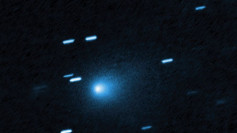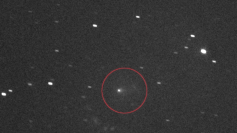The interstellar comet 3I/ATLAS, the third confirmed object to enter the solar system from beyond the Sun's gravitational influence, is set to become visible from Earth again beginning November 11, according to tracking data from NASA and multiple observatories. The object, which completed its closest pass around the Sun on October 30, will gradually brighten in the pre-dawn eastern sky throughout November, offering a rare chance for astronomers and amateurs to observe a visitor from another star system.
3I/ATLAS first gained broad public attention earlier this year when scientists noted unusual characteristics, including a faint glow and a bluish tint. NASA has emphasized that the comet's hyperbolic trajectory confirms that it originated beyond the solar system, making it only the third such object ever recorded. The comet's approach has also attracted renewed interest due to prior debates among researchers regarding its composition and appearance.
According to Times Now, the comet passed within roughly 130 million miles of the Sun during perihelion, causing frozen gases on its surface to sublimate and form a minimal, diffuse coma. As it travels outward, that glow will remain observable through mid-December. 3I/ATLAS will reach its closest point to Earth on December 19, at a distance of approximately 168 million miles.
Astronomers recommend observing the comet before sunrise. Beginning November 11, it will rise around 4:34 a.m. local time and appear low on the eastern horizon before climbing approximately 32 degrees above the southern horizon. Clear skies, low light pollution, and unobstructed viewing angles greatly increase visibility.
Specialized equipment will be necessary. The comet's magnitude is estimated at 9.8, significantly dimmer than the threshold visible to the naked eye. Telescopes with at least an 8-inch (20-centimeter) aperture are recommended, though larger models will improve clarity. Harvard astrophysicist Avi Loeb has stated that the object can be viewed "with any telescope wider than 30 centimeters," reinforcing the need for intermediate to advanced optical instruments.
At present, 3I/ATLAS is located in the constellation Virgo at Right Ascension 13h 11m 01s and Declination -05° 30' 28", approximately 329 million kilometers from Earth. Tracking applications developed by NASA and the European Space Agency provide real-time positional data for observers.
Even with proper equipment, the comet may remain visually subtle. Researchers have pointed to its faint bluish tint and irregular light scattering patterns as indicators of unfamiliar interstellar dust composition. Its brightness is expected to increase slightly through late November, but scientists note that it will never reach a level visible without magnification.
After passing near Jupiter in March 2026, 3I/ATLAS will continue outward and is not expected to return.





